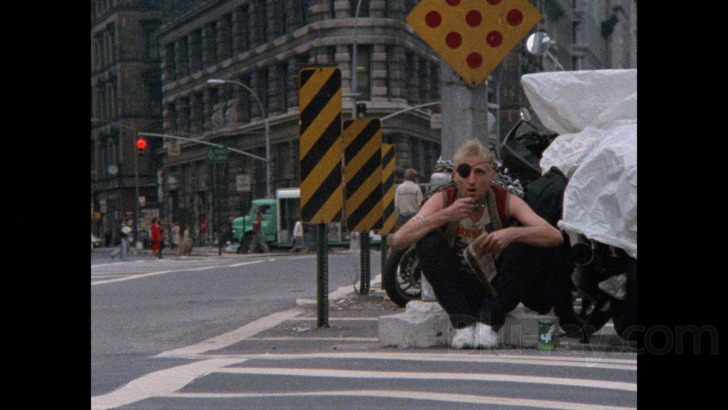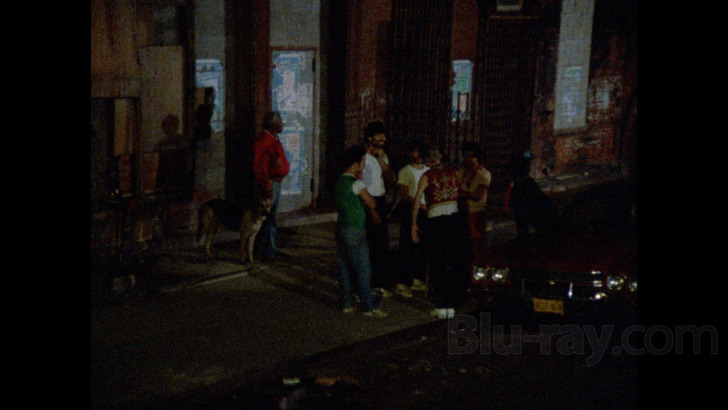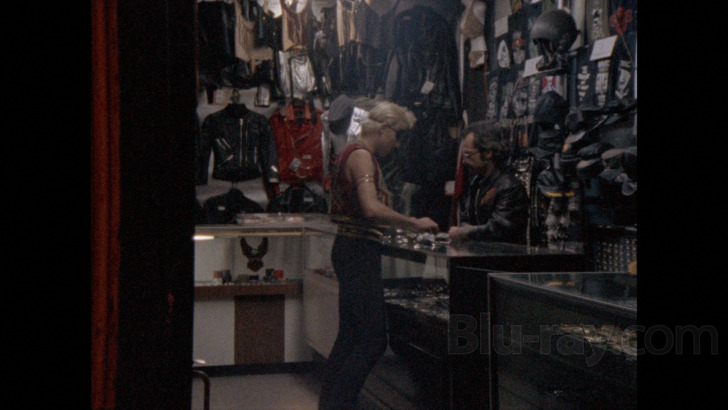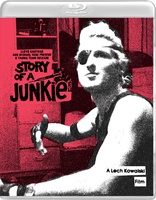Story of a Junkie Blu-ray Movie
HomeStory of a Junkie Blu-ray Movie 
Gringo / Blu-ray + CDVinegar Syndrome | 1985 | 80 min | Rated R | Apr 30, 2024
Movie rating
7.2 | / 10 |
Blu-ray rating
| Users | 0.0 | |
| Reviewer | 4.0 | |
| Overall | 4.0 |
Overview
Story of a Junkie (1985)
Critically Acclaimed documentary from director Lech Kowalski (DOA) following the life and times of a down-and-out heroin addict in 1980s New York.
Starring: John SpacelyDirector: Lech Kowalski
| Documentary | 100% |
Specifications
Video
Video codec: MPEG-4 AVC
Video resolution: 1080p
Aspect ratio: 1.33:1
Original aspect ratio: 1.33:1
Audio
English: DTS-HD Master Audio 2.0
Subtitles
English SDH
Discs
Blu-ray Disc
Two-disc set (1 BD, 1 CD)
Packaging
Slipcover in original pressing
Playback
Region A, B (C untested)
Review
Rating summary
| Movie | 4.0 | |
| Video | 4.5 | |
| Audio | 4.0 | |
| Extras | 4.5 | |
| Overall | 4.0 |
Story of a Junkie Blu-ray Movie Review
Reviewed by Brian Orndorf June 11, 20241985’s “Story of a Junkie” welcomes viewers to Hell, or at least a decent replication of it, found in New York City’s Lower East Side during the early 1980s. Director Lech Kowalski goes the cinema verite route for the endeavor, which presents the experiences and thoughts of John Spacely, a drug addict working the routine of his life in an especially rough neighborhood. The helmer creates a spare, unflinching look at this daily struggle, but “Story of a Junkie” doesn’t seek to help Spacely, simply generating a dramatic space for him to exist in. It’s a picture of thoughts and addictions, and while it tends to get a little lost in occasional ramblings, Kowalski captures a time and place with authority, displaying misery for all to see.

There isn’t a plot to “Story of a Junkie.” Instead of drama, Kowalski goes observational, following Spacely as he faces daily challenges to his physical and mental health. It’s not a documentary, using staged moments to achieve an understanding of reality, remaining an effective approach to understand the “wandering soul” and his struggles. “Story of a Junkie” takes cameras into drug dens to study users and dealers, with the business of selling cocaine and especially heroin of primary concern to the feature. These systems of supply and demand are fascinating to see, watching as desperate people visit rotting buildings, offering cash for fixes, with quality more of a “luck of the draw” situation for all. This understanding of commerce is often wild to witness, bringing a bizarre sense of order to chaos.
Spacely is the lead performer in “Story of a Junkie,” with details from his life periodically coming into view. He has a girlfriend of some sort in Suzanne, and photos from his California upbringing are shared. Spacely buzzes around the neighborhood on his skateboard, and when he’s not using, he’s focused on making money to purchase a fix, referring to it as an “adventure.” Needle use is quite real in “Story of a Junkie,” and Kowalski often includes unnervingly quiet moments to remind viewers of the end game, with these temporary pauses followed by groggy thoughts shared by bombed-out people. The scenes tend to bring the endeavor to a full stop, though the creative intent is clear, offering time to understand the chemical change in users.
Story of a Junkie Blu-ray Movie, Video Quality 

The AVC encoded image (1.33:1 aspect ratio) presentation is listed as "newly scanned and restored in 4K from its 16mm original camera negative." There's a level of age to the source, with mild scratches and judder, and some brief frame damage is encountered. Detail reaches as far as possible, offering a decent look at the world of "Story of a Junkie," which takes viewers into dilapidated buildings and around ruinous city streets. Texture is decent with locations, and character appearances are appreciable. Skin surfaces also do well. NYC distances are dimensional, and the claustrophobic nature of the drug dens is preserved. Color is capable, with a cooler sense of street activity, which mostly takes place at night. Signage and lighting offers brighter hues, and Spacely's appearance registers with distinct hair color and fashion choices. Blood red is also defined. Delineation is satisfactory. Grain is heavy and film-like.
Story of a Junkie Blu-ray Movie, Audio Quality 

The 2.0 DTS-HD MA mix obviously isn't built for power, and some age and technological limitations are encountered during the listening event. For the most part, dialogue exchanges are clear, listening to story time from the characters or their scattered street conversations. Unintelligibility isn't an issue here. Scoring and soundtrack cuts are acceptable, supporting the movie's atmosphere. Atmospherics are appreciable.
Story of a Junkie Blu-ray Movie, Special Features and Extras 

- Soundtrack CD is included.
- "The Dance of Death" (18:52, HD) is an interview with director Lech Kowalski, who identifies the cultural importance of the Lower East Side, inspired to make a movie about the location and the path of drugs in the neighborhoods. Endeavoring to capture "real life," the helmer hunted for a way to work a story into his filmmaking interests, starting his journey by collecting footage. The interviewee examines his neorealism inspirations, using these ideas to help shape characterizations in "Story of a Junkie." He also explores how his cast came together, working to wrangle some of the personalities, following their lead when dealing with local criminals, moving carefully to document the scene. Kowalski also recalls the creation of the mural in the feature, and his relationship with John Spacely.
- "Thirteen Weeks of Hell" (10:37, HD) is an interview with editor Val Kuklowsky, who was L.A.-based when he was introduced to director Lech Kowalski. The interviewee tracks his introduction to the world of editing, facing a major challenge in the shaping of "Story of a Junkie," fighting to create a narrative and figure out a creative approach to the feature. Kuklowsky discusses his interactions with John Spacely, and his appreciation of his presence on film. The lasting power of "Story of a Junkie" is also celebrated.
- "Drop the Needle" (12:13, HD) is an interview with composer Chuck Kentis, who started playing in bands in the 1970s, finding the scene around New Jersey, where he met Val Kuklowsky's brother. Getting a gig through the connection, Kentis used his experience to create the sonic landscape of "Story of a Junkie." The interviewee examines his musical inspirations and achievements, hunting for an unusual sound, especially when focusing on needle-centric sequences. Kentis also shares his own experiences in the drug scene, responding to the reality of "Story of a Junkie."
- Archival Interview (10:17, SD) is a discussion of "Story of a Junkie" with producer Ann Barish, conducted by Troma Entertainment's Lloyd Kaufman. The pair discuss the authenticity of the movie while walking the streets of New York City, with Barish identifying efforts to corral the cast and secure the neighborhood. She also explores the life and times of John Spacely, and highlights critical and audience response to the film, reinforcing how hard the production worked to avoid preachiness. The pair are eventually interrupted by a pedestrian willing to share his story of addiction and recovery.
- "The Last Stop on the Train" (4:31, HD) is a brief interview with Troma Entertainment's Lloyd Kaufman, who celebrates the authenticity of "Story of a Junkie," and its depiction of New York City at the time. Admitting that director Lech Kowalski wasn't delighted with the choice of Troma as a distributor, Kaufman shares release efforts and roadblocks, and praises the picture's quality, suggesting the movie is something "film lovers become addicted to."
- A Trailer has not been included on this release.
Story of a Junkie Blu-ray Movie, Overall Score and Recommendation 

"Story of a Junkie" certainly isn't an easy sit. Viewers are treated to some graphic imagery with needle use and dope-sickness, and Spacely details a few horrific experiences in his life, including his casual disposal of a miscarried fetus. There's an educational value to the film that keeps it compelling, allowing viewers to explore the Lower East Side event as it once was, with its post-apocalyptic atmosphere and volatile residents. "Story of a Junkie" remains interesting even at its most disturbing and hopeless, offering a vivid tour of the neighborhood and the strange personalities of its desperate inhabitants and visitors.
Similar titles
Similar titles you might also like

Blood, Guts and Sunshine
Slipcover in Original Pressing
2021

The AGFA Horror Trailer Show
2020

Tales of the Uncanny
Black Friday Exclusive Limited Edition
2020

Satanis: The Devil's Mass
1970

The Killing of America
1981

Best Worst Movie
2009

The Scare Film Archives Volume 2: Danger Stories
2025

The Forbidden
1966

Lost Soul: The Doomed Journey of Richard Stanley's Island of Dr. Moreau
House of Pain Edition
2014

Mail Order Murder: The Story Of W.A.V.E. Productions
Standard Edition
2020

Popatopolis
2005-2009

Mondo Balordo
1967

The Scare Film Archives Volume 1: Drug Stories!
2018

The Vault of Amicus
2017

Growing Up with I Spit on Your Grave
2019

Vinyl Nation
Slipcover in Original Pressing
2020

King on Screen
2022

The First VCR
2019

Cassettes Go Hi-Fi
2019

Mondo Freudo
1966
